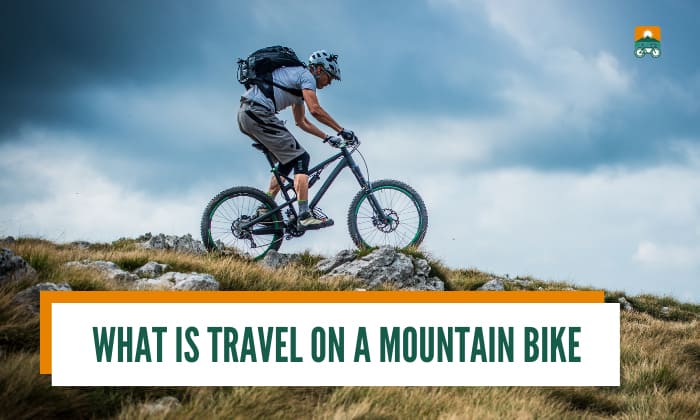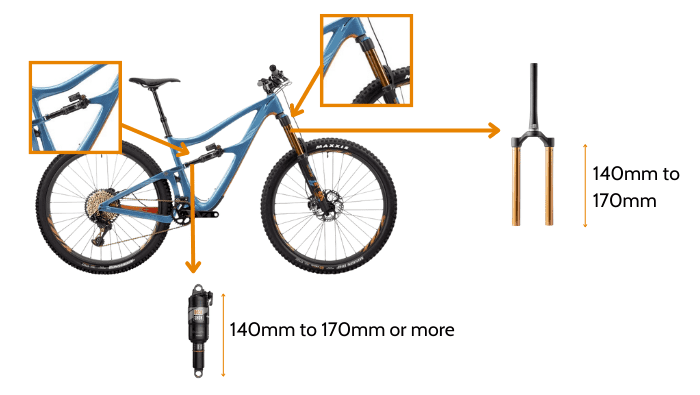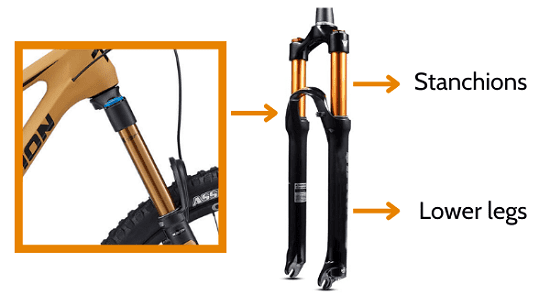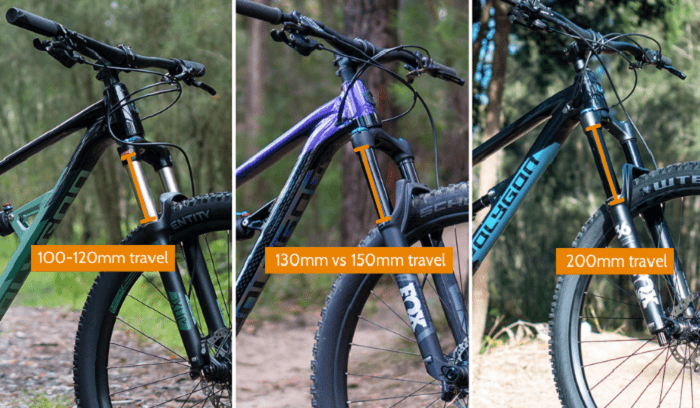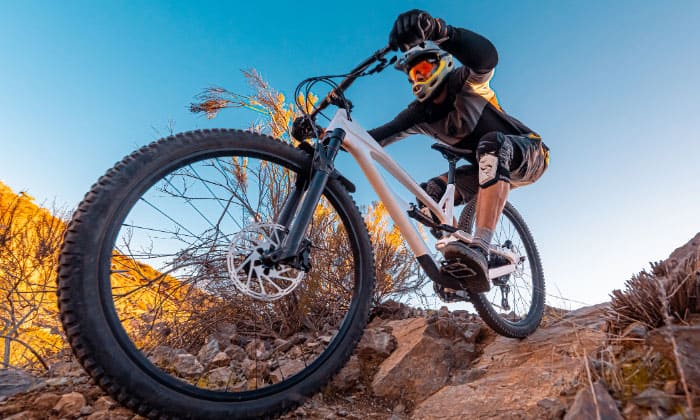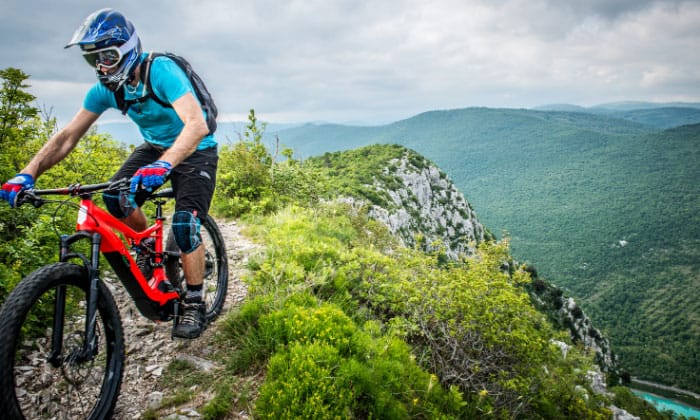Traveling on a mountain bike takes you off the beaten track and offers several physical challenges. You might have to ride up steep hills and navigate rocky trails that require precise bike handling skills to maintain control.
In this case, mountain bike travel is here to play a role. It’s not about your adventure but a tool to enhance your riding experience.
So what is travel on a mountain bike? Read on to learn about mountain bike travel and explore its mechanism of action. Moreover, some useful tips are also provided to help you to get the most out of your mountain biking adventures.
Table of Contents
Travel on a Mountain Bike: What’s It?
Travel on a mountain bike refers to the amount of suspension travel the bike’s front and rear can provide. Suspension travel is the distance the suspension can compress and rebound, measured in millimeters (mm).
Mountain bikes are designed to handle rough terrain and uneven surfaces, so good suspension travel can significantly absorb the impact of bumps and shocks, eventually providing a smoother and more comfortable ride.
Types of Travel
Short Travel
- Front suspension forks with travel of up to 120mm, and no rear suspension.
- Ideal for cross-country riding.
Mid Travel:
- Front suspension forks with travel of 120mm to 140mm
- Rear suspension with travel of 120mm to 140mm.
- Best for trail riding.
Long Travel:
- Front suspension forks with travel of 140mm to 170mm
- Rear suspension with travel of 140mm to 170mm or more.
- Ideal for enduro racing and downhill riding.
Short Travel Vs Long Travel MTB?
By having more suspension travel, long travel mountain bikes are best fit for aggressive, technical riding by providing more cushion and shock absorption on rough terrain, allowing riders to maintain control and momentum in challenging conditions.
However, they are not the ideal type of bike for all riders and terrain types. They tend to be heavier and less efficient at pedaling and climbing. It might be a waste if you purchase a long travel bike for smoother terrain or long endurance rides only.
So, you should choose short travel mountain bikes instead, which are also known as XC or short travel trail bikes. They are the best option for beginners and those who prioritize agility and don’t want to lose too much energy.
Mid Travel vs long Travel?
When you find it hard to make the decision, it’s recommended to choose a mid travel mountain bike. This special bike is a combination of the long travel bike and the short travel one, which eventually make them a good all-around choice for most riders.
It can handle both technical terrain and steep descents, but is also efficient enough for climbing.
1. Front suspension
Front suspension, also known as a suspension fork, is located at the front of the bike.
The suspension fork typically consists of two main components: the stanchions and the lower legs.
- Stanchions: the upper part of the fork, which slides up and down inside the lower legs.
- Lower legs: contain the suspension mechanism, typically one or more air springs or coil springs, and damping mechanisms such as hydraulic or mechanical systems.
They also come in different types of travel, depending on the type of mountain bike, such as 80mm – 120mm (Cross-country MTB) and up to 200mm with downhill bikes.
2. Rear suspension
There are several different designs used in mountain bike suspension systems:
- Single pivot: Uses one pivot point between the swingarm and the mainframe. It is simple and easy to maintain, but can be less efficient and more prone to pedal bob than other types of pivots.
- Horst link: Together with a pivot point between the swingarm and the mainframe, a horst link suspension system also uses a pivot point above and somewhat forward of the rear axle.
Despite having better anti-squat properties and increased pedaling efficiency, it can be more complex and challenging to maintain than a single pivot.
- DW-Link: Makes use of two pivot points that are aligned along the bike’s chainstay and seatstay, and are connected by a linkage system. It provides excellent traction and anti-squat characteristics, but can be more complex and difficult to tune than others.
- Flex pivot: Has a flexible rear triangle that can bend and twist to absorb shocks and vibrations. It is simple and lightweight, but may not provide as much shock absorption as other types of pivots.
How Much MTB Suspension Travel Do I Need?
The amount of front travel on a mountain bike you need will depend on several factors, including your riding style, the terrain you’ll be riding on, and your personal preferences.
1. 100-120mm travel
If you primarily ride on smooth or moderately rough terrain, such as dirt roads, trails, and light singletrack, the travel you need on a MTB should only range from 100mm to 120mm. This will provide enough shock absorption to improve your comfort and control without adding unnecessary weight or complexity to your bike.
2. 130mm vs 150mm travel
A 130mm travel mountain bike fork is typically used for cross-country or light trail riding with moderate technical features. Meanwhile a 150mm travel fork is more commonly used for trail and enduro riding with more intense terrain.
Some riders may prefer a 130mm fork for more technical riding, while others may find a 150mm fork to be too much for their needs.
3. 200mm travel
200mm is the most suitable fork travel you should use for downhill riding. It offers the maximum amount of shock absorption and maintenance, allowing you to tackle the most challenging terrain with confidence and agility.
A 150mm travel fork is enough for downhill riding depending on the specific trail and the rider’s skill level and preferences.
However, purchasing a bike with a longer travel fork for long-term usage is the best option since it will have better performance and provide smoother rides.
How to Choose a Suitable Travel for Mtb?
The type of riding you plan to do will have a big impact on the amount of travel you need. If you are interested in having strong feelings with steep descents and drops, a longer travel fork is what you need.
If you prefer smooth rides like cross-country trails, a shorter travel fork may be sufficient, you may not need as much travel as someone who rides tricky terrain.
Frequently Asked Questions
Tips to balance suspension with a full suspension mountain bike
The amount of travel in the front and rear suspension should be balanced to ensure optimal shock absorption and control.
You should begin by following this step:
- Read and follow the manufacturer’s guidelines for setting the sag (the amount of compression in the suspension when you sit on the bike)
- Adjust the air pressure or preload as needed to achieve the desired sag.
- Adjust rebound and compression damping to help balance the suspension and provide optimal shock absorption.
If you’re having difficulty balancing the suspension on your bike, consider getting professional help from experts.
What is a good amount of travel for a mountain bike?
The amount of suspension travel varies depending on the type of riding the bike is intended for. Bikes with less suspension travel have increased pedaling efficiency, lighter weight and lower maintenance requirements.
Otherwise, bikes with more suspension travel provide increased traction and better performance in extreme terrain at high speeds. The more suspension travel the bike has, the more it can absorb impacts and maintain contact with the ground, which can reduce the risk of crashes and improve the rider’s control.
Hardtail and full suspension
Hardtail suspension and full suspension are two different types of mountain bike suspensions. What is the best choice for your ride?
The answer is: It depends. So here are some aspects to consider before making a decision:
- Design: A full suspension bike has both a suspension fork in the front and a rear suspension system, but a hardtail suspension only features a suspension fork in the front and a rigid frame on the rear of the bike.
- Comfort: Full suspension bikes provide more comfort and better shock absorption than hardtail ones since they have more suspension systems.
- Efficiency: Hardtail suspensions are more efficient in pedaling and climbing due to their rigid rear frame that transfers power directly to the pedals. Full suspension bikes, however, require less effort when riding on uneven trails.
Conclusion
What is travel on a mountain bike? What is the difference between them and how much travel do you need for a MTB? These are our answers and some tips to help you address any hitch about this topic.
We hope that by providing this helpful information, you will know what travel means on a bike and make a better decision for your next trip.

“I ride my bike to work for years, but is that enough? Our carelessness towards our surroundings has taken a toll on the environment. And now, everyone is responsible for changes; even the most minor contribution is counted. With this hope and spirit, I started with my partner to establish Biketoworkday to help more individuals commute to their work sites on their bikes.”

